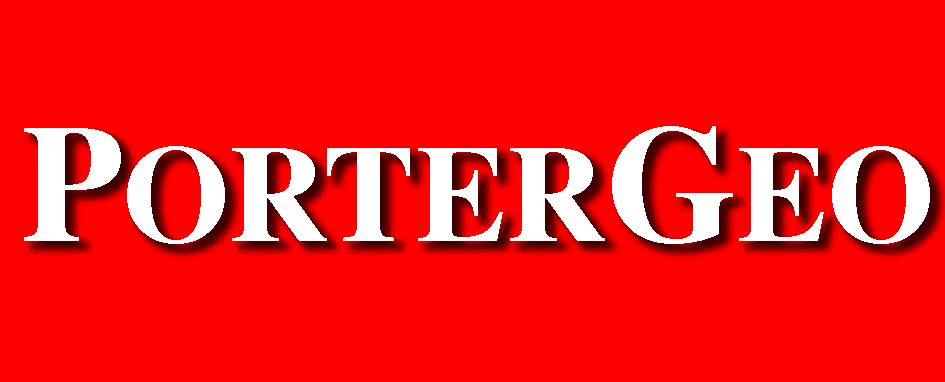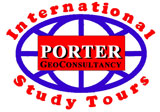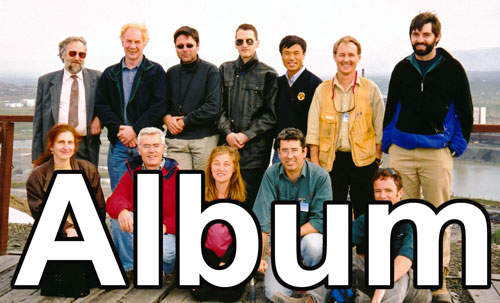| |||||||||||
|
Pacific Gold '99 Major Gold Deposits of the Western Pacific Margin 12 to 28 September 1999 | |||||||||||
|
| |||||||||||

The Australian Mineral Foundation and Porter GeoConsultancy conducted a professional development course that visited a selection of the different styles of major gold deposits found along the western Pacific rim.
This 16 day tour visited seven major epithermal and porphyry gold deposits in Papua New Guinea (PNG), Indonesia, the Philippines and Japan. It commenced in Port Moresby, PNG, on Sunday 12 September, 1999, and finished in the late afternoon of Tuesday 28, in Kagoshima, Kyushu, Japan. It was divided into two modules, with participants able to take one or both. In addition to the mine visits, there were workshops, some field based, presented by local and internationally known experts. These were designed to provide an overview of the regional tectonic, geological and metallogenic setting of the regions and deposits visited. It was also supported and promoted by the Geological Society of South Africa, the Mineral Deposits Division of the Geological Association of Canada and ADIMB (Brazil), whose members were offered the same discounted rates as employees of Australian Mineral Foundation member companies.
The participants were from around the world, bringing a breadth of international experience to broaden and enrich the discussion and hence enhance the tour. The two modules included the following:
After the group assembled in Port Moresby, the first module commenced with an air charter flight to Lihir Island, 920 km to the northeast. That night, a member of the tour group gave a presentation to the geological staff of Lihir Gold covering a significant gold project with which he had experience. Next morning, the group was given a comprehensive geological visit to the low sulphidation Lihir Gold open pit operation, including office presentations, inspection of exposures in the pit and drill core inspection. Later that afternoon, they departed on the tour charter aircraft to fly via Hoskins on New Britain island, to Madang, 800 km to the WSW, on the mid north coast of the Main Island of New Guinea. Next morning, they left early to fly, in the same charter aircraft, to Porgera, 300 km to the west. After transferring from the airstrip, they were given a full day visit to Placer Dome's Porgera deposit. In the evening one of the tour group, a senior Canadian, gave a presentation to Porgera geological staff on the gold deposits of the Abitibi Greenstone Belt in Canada. The group overnighted in Porgera, before flying 135 km to the ESE to Mount Hagen next morning, to clear Customs and Immigration. They then flew west, over the border, to Merauke in West Papua, Indonesia. Following immigration and customs, the charter aircraft flew on to Timika where the PT Freeport Indonesia exploration unit is based. That ended the charter, and the aircraft flew back to Papua New Guinea. During the afternoon and evening, over a barbecue, the group received a geological introduction to the Grasberg mines, followed by a presentation from one of the group members for the Freeport geologists. Early next morning, they were taken by special bus, from the hot humid coastal plains just above sea level at Timika, to Tembagapura, the dormitory town for Freeport's mines at an altitude of 2000 m. Most of that altitude difference was climbed over the last 20 km on precipitous roads and through tunnels. On arrival they were given a comprehensive underground visit to the Kucing Liar and Big Gossan Cu-Au skarn deposits below/adjacent to the Grasberg and Ertzberg porphyry systems. After overnighting at Tembagapura, they were given a comprehensive visit to the Grasberg porphyry Cu-Au deposit. In 1999, the Grasberg-Ertzberg operation was the world's largest gold producing mine. Late in the afternoon, they returned to Timika by bus to overnight. This marked the end of Module 1. Those not taking module 2 had arranged their own commercial airline flights from Timika, while the rest flew to Ujung Pandang (Makassa) to overnight, before flying to Manado in northern Suluwesi, Indonesia next day, Sunday 19 September.
New tour members rendezvoused with the through-going group in Manado, northern Suluwesi, on the evening of Sunday 19 September. Early next morning, they were taken on a two and a half hour bus transfer to Newmont's 'Carlin-like' Mesel sediment hosted gold deposit, within a Miocene carbonate-siliciclastic sequence, intruded by hornblende-plagioclase phyric andesite. They returned to Manado that evening. Next morning they were given a detailed presentation on the epithermal quartz-adularia-electrum Toka Tindung and Talawaan gold deposits, also in northern Suluwesi, by the Exploration Manager and staff of Aurora Gold, the operator of the venture. That afternoon, the group flew to Singapore to overnight before flying on to Manila next day, Wednesday 22nd. On the following morning they departed early on two charter aircraft to fly north for 260 km, directly into the mine airstrip at Mankayan. On arrival they were given a full day visit, hosted by Lepanto Consolidated Mining Company, involving a detailed presentation, underground visits and drill core inspection of the Lepanto Complex deposits. These include the Far Southeast (FSE) porphyry Au-Cu, Lepanto high sulphidation epithermal enargite-luzonite-gold Au-Cu deposits and Victoria-Teresa intermediate sulphidation Au-Ag veins. Late that afternoon, the group departed Mankayan on the two charter aircraft and travelled to Baguio City, 50 km to the south to host a dinner for Benguet Corporation geological staff, our hosts of the next day, and then to overnight. Next day, Friday 24th, was taken up with a full day field workshop. This comprised presentations by senior Benguet Corporation geologists on the Baguio district geology and mineralisation, and a reciprocal talk by a group participant on a major gold deposit in Brazil. The group then went into the field, led by Benguet Corporation geologists, to inspect pits on the key epithermal and porphyry style mineralisation in the Baguio District, including Antamok and Acupan. 
Late that afternoon, the group re-boarded the charter aircraft to depart for Manila before last light. Saturday 25th was taken up with travel, flying from Manila, via Osaka to Fukuoka in Kyushu, Japan, where the group was joined by internationally renowned expert, Professor Sachihiro Taguchi of Fukuoka University. In the late afternoon they travelled on by charter bus to the town of Kujyu to overnight. The next day began a 3 day field workshop that involved visits to the Hatchobaru and Otake geothermal fields and power plants and to the Aso Volcano. The workshop incorporated visits to the Hishikari adularia-sericite low sulphidation bonanza vein epithermal gold deposit and the smaller Kasuga silica-acid sulphate high-sulphidation epithermal Au deposit. The overall aim of the workshop was to understand the volcanic and geothermal architecture, mineralisation and alteration systems, and the relationship between the ongoing geothermal/hydrothermal activity and gold mineralisation. At one of these geothermal power stations, scale being precipitated in the pipes feeding steam to the turbines carries 5 g/t Au with associated adularia and other minerals found in low sulphidation systems. The workshop, the module and tour ended on the afternoon of Tuesday 28 September, with a visit to the active Sakurajima Volcano (image to right) at Kagoshima on southern Kyushu. That evening and next morning, the tour group dissipated, going their separate ways to their home bases around the world. This study tour was planned, organised and managed by Porter GeoConsultancy as a professional development course on the curriculum of the Australian Mineral Foundation. | |||||||||||
| |||||||||||
|
| |||||||||||












